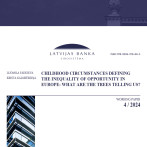Manufacturing volumes growing, yet tougher times ahead
According to the data of the Central Statistical Bureau, manufacturing output (seasonal effects excluded) in February grew 0.2% month-on-month. The annual growth rate has once again turned positive, at 1.9%. The total industrial output (including the energy industry and mining and quarrying) has dropped by 2.6% as a result of the relatively warm February.
In a breakdown by sub-branch, the monthly fluctuations do not point to fundamental changes in trends, with the exception of the negative trend in metals (a month-on-month drop of 19.5%). In February, metal production output was 27.2% lower than the 2012 monthly average. That, of course, is explained by the drop in the production levels of AS "Liepājas Metalurgs". This month, the drop in the metal production was almost fully compensated by a small increase in (by 5.0%), once again chiefly due to the increase in the output of processed, rather than un-processed products . Nevertheless, it is unlikely that in the coming months any of the other sectors will be able to compensate the drop in the output in the metal production.
The recently observed saw-liketrend in manufacturing production is likely to change in March when manufacturing output is predicted to drop. This is currently evidenced by all available statistics. The European Commission’s confidence indicators and PMI point to a worsening in industry in Europe. Eurostat data indicate that manufacturing in the European Union has registered decreasing production output in four out of the last five months. Moreover, the situation is rapidly deteriorating in sectors important to Latvia: construction in Europe in stagnating (a negative impact on the exports of in the wood and metal sectors), signs of recession are observed in the auto industry (a negative effect on those Latvian enterprises that produce parts for automobile production), there are still no positive signs in the European metallurgy sector. The negative effects stemming from Europe are thus expected to increase in the near future.
Manufacturing has previously demonstrated an ability to grow under unfavourable global conditions; however, this time around we have to take into account the local developments at AS "Liepājas Metalurgs". The future prospects of the company are not entirely clear yet, but it is plain to see that the lack of current assets is preventing the enterprise from being fully operational (this was obvious even before from the fluctuating output data of the metal sector). In case the worst case scenario comes to pass and AS "Liepājas Metalurgs" is not saved, the annual growth rate of the manufacturing output would in all likelihood become negative. Nevertheless, that would not mean a new economy-wide crisis. Iron ore, is not mined in Latvia (at least not on an industrial scale), therefore the raw materials are imported. For that reason, the proportion of value added in the metal sector is very low in Latvia. In the press it is often stressed that "Liepājas Metalurgs" is the largest exporter while forgetting to note that it is also one of the biggest importers. Thus a direct impact on gross domestic product (GDP) is unlikely to be all that significant (0.6%–0.7% of GDP); secondary effects, however, are more worrisome (a drop in the turnover of related enterprises, confidence effects, a drop in the purchasing power of laid off employees etc.).
Another thing to note: the lengthy winter has produced a positive effect from the industrial point of view: growth is expected in the power industry in the second quarter of this year. That will be ensured both by longer working of the heating equipment and more water in the Daugava basin, which will allow the hydroelectric plants to produce more power.
Textual error
«… …»






